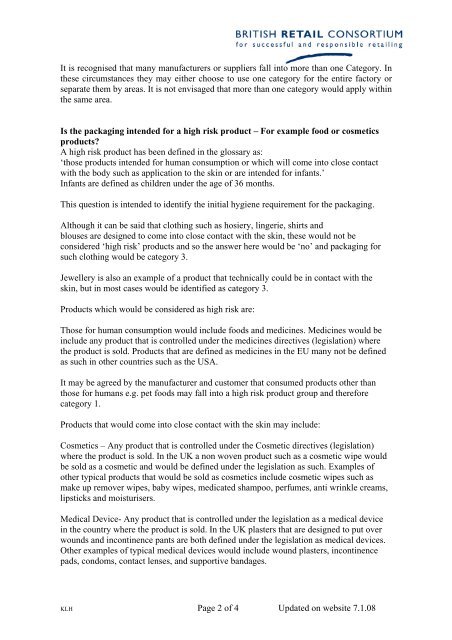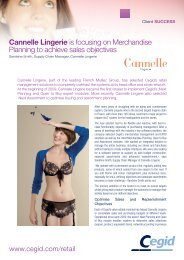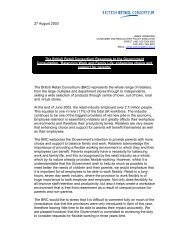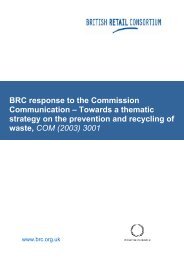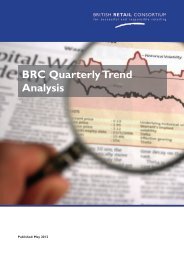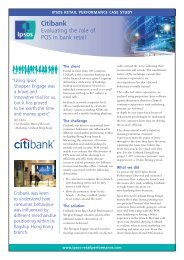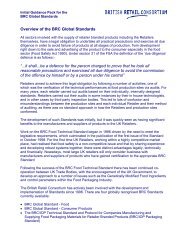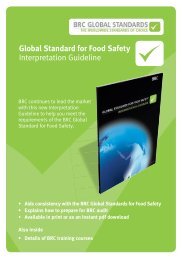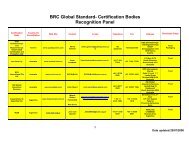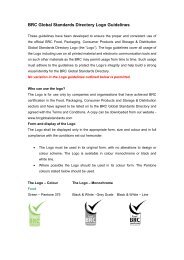Global Standard for Packaging and Packaging Materials Issue 3 ...
Global Standard for Packaging and Packaging Materials Issue 3 ...
Global Standard for Packaging and Packaging Materials Issue 3 ...
You also want an ePaper? Increase the reach of your titles
YUMPU automatically turns print PDFs into web optimized ePapers that Google loves.
It is recognised that many manufacturers or suppliers fall into more than one Category. In<br />
these circumstances they may either choose to use one category <strong>for</strong> the entire factory or<br />
separate them by areas. It is not envisaged that more than one category would apply within<br />
the same area.<br />
Is the packaging intended <strong>for</strong> a high risk product – For example food or cosmetics<br />
products?<br />
A high risk product has been defined in the glossary as:<br />
‘those products intended <strong>for</strong> human consumption or which will come into close contact<br />
with the body such as application to the skin or are intended <strong>for</strong> infants.’<br />
Infants are defined as children under the age of 36 months.<br />
This question is intended to identify the initial hygiene requirement <strong>for</strong> the packaging.<br />
Although it can be said that clothing such as hosiery, lingerie, shirts <strong>and</strong><br />
blouses are designed to come into close contact with the skin, these would not be<br />
considered ‘high risk’ products <strong>and</strong> so the answer here would be ‘no’ <strong>and</strong> packaging <strong>for</strong><br />
such clothing would be category 3.<br />
Jewellery is also an example of a product that technically could be in contact with the<br />
skin, but in most cases would be identified as category 3.<br />
Products which would be considered as high risk are:<br />
Those <strong>for</strong> human consumption would include foods <strong>and</strong> medicines. Medicines would be<br />
include any product that is controlled under the medicines directives (legislation) where<br />
the product is sold. Products that are defined as medicines in the EU many not be defined<br />
as such in other countries such as the USA.<br />
It may be agreed by the manufacturer <strong>and</strong> customer that consumed products other than<br />
those <strong>for</strong> humans e.g. pet foods may fall into a high risk product group <strong>and</strong> there<strong>for</strong>e<br />
category 1.<br />
Products that would come into close contact with the skin may include:<br />
Cosmetics – Any product that is controlled under the Cosmetic directives (legislation)<br />
where the product is sold. In the UK a non woven product such as a cosmetic wipe would<br />
be sold as a cosmetic <strong>and</strong> would be defined under the legislation as such. Examples of<br />
other typical products that would be sold as cosmetics include cosmetic wipes such as<br />
make up remover wipes, baby wipes, medicated shampoo, perfumes, anti wrinkle creams,<br />
lipsticks <strong>and</strong> moisturisers.<br />
Medical Device- Any product that is controlled under the legislation as a medical device<br />
in the country where the product is sold. In the UK plasters that are designed to put over<br />
wounds <strong>and</strong> incontinence pants are both defined under the legislation as medical devices.<br />
Other examples of typical medical devices would include wound plasters, incontinence<br />
pads, condoms, contact lenses, <strong>and</strong> supportive b<strong>and</strong>ages.<br />
KLH Page 2 of 4 Updated on website 7.1.08


